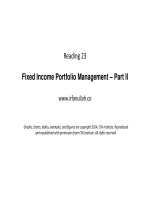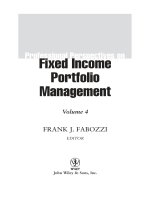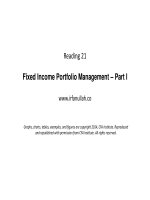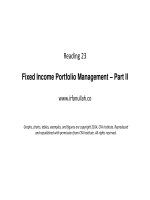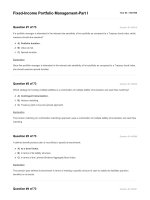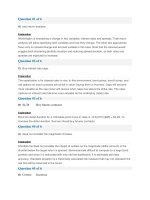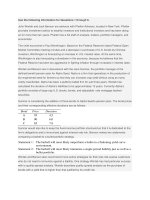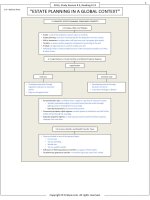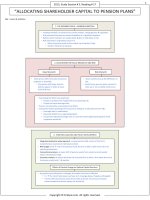FinQuiz smart summary, fixed income portfolio management
Bạn đang xem bản rút gọn của tài liệu. Xem và tải ngay bản đầy đủ của tài liệu tại đây (619.78 KB, 8 trang )
1
2013, Study Session # 10, Reading # 25
“FIXED-INCOME PORTFOLIO MANAGEMENT-PART II”
BSA = Breakeven Spread Analysis
EMD = Emerging Market Debt
RFR = Risk Free Rate
RA = Repurchase Agreements
SD = Standard Deviation
CDS = Credit Default Swap
I.R = Interest Rate
5. OTHER FIXED-INCOME STRATEGIES
No. of alternatives available to enhance performance
whether managing against index or liabilities.
5.1 Combination Strategies
Active / passive combination ⇒ core component of portfolio to
passive strategy (to replicate an index) & balance to active
component (return maximization strategy).
Active / immunization combination ⇒ immunized portfolio provide
assured return while second portfolio use high return / risk strategy.
5.2 leverage
To magnify portfolio’s rate of return.
When leverage used I.R sensitivity of equity in portfolio increase.
5.2.1 Effects of Leverage
Two relationships
Amount of borrowed funds,
Variability in annual return,
Portfolio rate of return
Leverage
variation in potential outcome.
risk.
equity duration given duration of liabilities < duration of assets
A&L represent market value of assets & liabilities.
Copyright © FinQuiz.com. All rights reserved.
2013, Study Session # 10, Reading # 25
5.2.2 Repurchase Agreements
Contract involving sale of securities coupled with an agreement to repurchase the
same on a later date.
Repo rate = diff. b/w selling price & purchase price.
Repo provide low cost funding to borrower & return above Rf to lender.
RA have short terms to maturity usually overnight to few days but can be rolled
over.
Transfer of securities can take variety of forms as.
Physical delivery (high delivery cost)
Bank acting as clearing agent for customer or electronic transfer of securities
(cheaper than physical delivery, but still fee & transfer charges).
Deliver securities to custodial accounts at seller’s bank (minimum delivery
charges).
Delivery not insisted by buyer (long business history, very short term
transactions).
Factors affecting repo rate
Securities quality, repo rate.
Maturity, rate.
If physical delivery of securities required rate .
Short supply collateral, repo rate.
Federal fund rate, repo rate.
Seasonal factors also affect repo rate.
5.3 Derivatives-Enabled Strategies
Use of derivatives can be thought as means to create,
reduce or magnify factor exposures of an investment.
5.3.1 Interest Rate Risk
Sensitivity of F.I portfolios to I.R change.
Duration of securities being exchanged must be
matched to maintain portfolio duration
where DDO = dollar duration of old bond.
DN = duration of new bond.
Duration is not appropriate when I.R changes are large.
5.3.2 Other Risk Measures
If portfolio returns have normal distribution ⇒ SD is useful measure
(difficult in case of option securities).
Some alternative measures with focus on left hand side of distribution
are;
Copyright © FinQuiz.com. All rights reserved.
2
2013, Study Session # 10, Reading # 25
Alternative Measures
Semivariance
Shortfall risk
Dispersion of return below target return.
Challenging for large portfolios.
Not suitable for asymmetric returns.
Lose statistical accuracy (use half data).
Probability of not achieving some
specified return target.
Does not account magnitude of loss in
money term.
Value at risk
Probability & loss in monetary terms.
Ignore vary worst possible outcomes.
5.3.3 Bond Variance versus Duration
Variance of portfolio can be determined by weight, variance &
covariance b/w each pair of securities.
Two major problems related to variance.
No. of estimated parameters , when no. of bonds .
No. of parameters = No. of bond (No. of bonds + 1) / 2
Historical estimate are not useful because bond
characteristics change with passage of time.
5.3.4 Interest Rate Futures
Underlying instrument of T-bond future contract is 100,000 par, hypothetical 30-year,
6% coupon bond.
Bond with 15 year to maturity or call is delivery acceptable bond.
Conversion factor ⇒ based on price the deliverable bond would sell for at beginning
of delivery month.
Cheapest-to-deliver ⇒ least expensive bond selected by short.
Quality or SWAP option ⇒ acceptable treasury issue to deliver option.
Timing option ⇒ day of actual delivery in delivery month.
Wild card option ⇒ delivery after closed of exchange.
Copyright © FinQuiz.com. All rights reserved.
3
4
2013, Study Session # 10, Reading # 25
5.3.4.1 Strategy with Interest Rate Futures
Buying futures ⇒ duration & vice versa.
Liquidity, cost effectiveness & easy to take
short position are key advantages of using
futures.
Duration Management
Duration Hedging
Future used to maintain portfolio duration at its target value.
$ Duration of future = DD Per future contract × No. of futures contracts.
Future used to reduce I.R exposure.
Basis risk ⇒ basis (diff. b/w cash price & future price) change in an
unpredictable way.
Cross hedge ⇒ bond to be hedged is not identical to bond underlying in
future contract.
Hedge position substitute basis risk for price risk.
To minimize risk in cross hedge right hedge ratio should be choose.
where
DT = target duration
DI = initial duration
PI = initial MV of portfolio
DCTD = duration of cheapest-to-deliver
PCTD = price of CTD.
.
Yield β consider non constant yield spread in cross hedging.
Sources of Hedging Errors
Inaccurate duration
calculation
Inaccurate projected
basis value
Inaccurate yield β
5.3.5 Interest Rate Swaps
Contract b/w two parties to exchange periodic
interest payments based on notional principal.
5.3.5.1 Dollar Duration of an Interest Rate Swap
5.3.5.2 Application of a Swap to Asset/Liability Management
SWAP party with pay floating & receive fixed can view as;
long a fixed rate bond + short on floating-rate bond.
Duration of SWAP (floating-rate payer)
$ duration = DD of fixed rate bond - DD of floating rate bond.
Alter CF to better matches assets &liabilities.
To change duration of portfolio
IR swaps are low transaction cost vehicle.
5.3.6 Bond & Interest Rate Options
Options on future are more popular than options on physical.
A Call option gives the buyer the right to buy while a put option grants
the right to sell.
5.3.6.1 Bond Option & Duration
Price of bond option depends on I.R on underlying instruments.
Duration for an option = delta of option × duration of underlying × leverage.
Where leverage = price of underlying / price of option.
Duration of call option is positive (positive delta) & duration of put options
is negative (negative delta).
Copyright © FinQuiz.com. All rights reserved.
5
2013, Study Session # 10, Reading # 25
5.3.6.2 Hedging with Options
Protective Put Buying
Covered Call Writing
Establish a minimum value for
portfolio.
Benefit when I.R .
Portfolio performance reduced by put
option cost.
Writer believes that market will not
trade much higher or much lower
than its present level.
Sale of call brings premium. (partial
protection if I.R )
If I.R price appreciation is limited
(liability as rates go down).
Covered call writing yields best result
if price are essentially going nowhere.
I.R caps ⇒ series of call options on I.R to create a cap for funding cost.
I.R floors ⇒ series of I.R put options (create minimum earning rate).
Collar ⇒ combination of cap & floors.
5.3.7 Credit Risk Instruments
Default Risk
Issuer may fail to meet
its obligations.
Credit Spread Risk
Downgrade Risk
Spread b/w risky bond &
Rf bond may vary after
purchase.
Major rating agency may
lower its rating for an
issuer.
5.3.7.1 Products That Transfer Credit Risk
Credit derivative exist to package & transfer credit risk
of a financial instrument or institution to another party.
Types of Credit Derivatives
Credit options
Binary options
Payoff dependent on
negative credit event
(default or rating).
Credit put option pay
diff. b/w X-S when credit
event occur & nothing if
no credit event.
Credit Forwards
Credit Spread options
Call option payoff based
on spread over
benchmark rate.
Payoff = max [(spread at
options maturity –K) ×
notional amount × risk
factor, 0] where K is
strike spread & risk
factor value ∆ for 1bps
∆in spread.
Payoffs based on bond value or
credit spread.
For a buyer of credit forward
pay off = (credit spread at
forward maturity – contracted
credit spread) × notional
amount × risk factor.
Copyright © FinQuiz.com. All rights reserved.
Credit Swaps
CDS ⇒ contract that shift
credit exposure of an asset
issued by reference entity from
protection buyer to protection
seller.
Used as hedging instrument
usually by banks.
More efficient to buy
protection in CDS rather to
selling or shorting asset.
6
2013, Study Session # 10, Reading # 25
6. INTERNATIOANL BOND INVESTING
Motivation ⇒ Risk reduction (low correlation) & return enhancement.
Low correlation among countries with weakest economic ties.
Local currency correlations > $ term correlation (due to currency volatility).
6.1 Active versus Passive Management
High opportunities for active management due to
inefficiencies in international markets.
Active Management Value Creation
Bond Market Selection
Currency Selection
Global economic factors analysis to
select national markets.
Sector Selection
Wide range of coupon, ratings &
maturities provide opportunities
through credit analysis.
Duration Management
Ability to forecast certain
exchange rates.
Distinct knowledge & skills
required (separately managed).
Credit analysis of issuers
Can enhance portfolio return.
Narrow selections of maturities
fixed income derivatives are used.
Investing in markets outside benchmark
Manager can add value through
superior credit analysis.
Benchmark is sovereign bonds.
Enhance return through non
sovereign bonds.
International I.R are not perfectly correlated so to measure international bond
portfolio duration, recognize correlation b/w movements in I.R in home country
& each nondomestic market.
∆ in value of foreign bond = - duration × ∆ in foreign yield given ∆ in domestic
yield ×100
∆y foreign = a + β ∆y domestic
β (country beta) = correlation (∆y foreign, ∆y domestic) × σ foreign / σ domestic.
6.2 Currency Risk
When foreign currency depreciates against investor’s home currency, currency
loss occurs & vice versa.
Multi-currency portfolio has less currency risk than a single currency portfolio.
Investors can hedge the currency risk or remain exposed to it.
6.2.1 Interest Rate Parity
Exchange rate difference = Rf IR difference (f = id – if).
Forward discount or premium
f = (F- So) / So
Where
F = forward exchange rate
So = spot exchange rate
Copyright © FinQuiz.com. All rights reserved.
7
2013, Study Session # 10, Reading # 25
6.2.2 Hedging Currency Risk
Decision on how much currency risk to hedge has important impact on return.
Type of currency hedge
Forward hedge
Proxy Hedge
Use forward contract to currency
hedge (b/w bond currency &
home currency).
Cross hedge
Use forward contract b/w home
currency & currency highly
correlated to bond currency.
Hedge using two currencies
outside home currency.
Convert currency risk to
another less risky exposure.
Variable CF bonds can’t be completely hedged through forwards.
Unhedged return = bond’s local currency return + currency return.
Hedged return = domestic RFR + bond’s local risk premium (excess return from local RFR).
If we compare hedged return across countries difference is only due to local risk premia.
6.3 Breakeven Spread Analysis
BSA ⇒ to quantify amount of spread widening required to diminish
a foreign yield advantage.
It does not account for exchange rate risk.
Yield advantage of foreign country investing may disappear if
domestic yield & foreign yield .
Break-even spread = ∆ in price/duration.
BSA must be associated with investment horizon & higher of two
countries durations.
6.4 Emerging Market Debt
EMD has low correlation with domestic debt portfolios, so offer
favorable diversification properties.
6.4.1 Growth & Maturity of the Market
Currently EMD has grown to substantial size due to Brady plan
(securitization of external bank loan).
Spread of EMD over RFR narrowed considerably (proportion of
investment grade debt increased).
EM indices represent lack of diversification.
6.4.2 Risk & Return Characteristics
Return
Potential for consistent, attractive rates of
return.
EM Govt possesses several advantage over
private corporation.
React quickly to negative eco events.
Access to lenders on world stage.
Possess large foreign currency reserves.
Risks
High volatility & significant negative
skewness.
Other risks
Lack of transparency.
Less developed legal system.
Over borrowed.
Recovery against sovereign states is very
difficult in case of default.
Lack of seniority structure.
Copyright © FinQuiz.com. All rights reserved.
8
2013, Study Session # 10, Reading # 25
6.4.3 Analysis of Emerging Market Debt
Analyst must determine willingness & ability of issuers to pay their debt
obligation (consider country’s fundamentals).
Company’s debt rating can’t be higher than sovereign debt rating (can
create mispricing opportunities).
Diversification among international securities is one mean to controlling
political risk on investment performance.
Sovereign EMD bears greater credit risk than developed market sovereign
debt.
7. SELECTING A FIXED-INCOME MANAGER
Focus on selection of active & consistent positive
style-adjusted alphas creative manager.
7.1 Historical Performance as a Predictor of Future Performance
Over a long period of time the realized alpha of active managers are close
to zero.
Pure historical performance based selection is not a good approach.
7.2 Developing Criteria for the Selection
Style analysis
Historical style may explain
type of biases & quality of
views.
Selection bets
Superior credit or security
analysis skill.
Manger’s skill measured by
decomposing portfolio’s
return.
Correlation of alphas
Prefer low correlation among
manager’s alphas to control
portfolio risk
7.3 Comparison with Selection of Equity Managers
Similarities b/w F.I & equity mangers.
Both use consultant to identify suitable mangers.
Past performance is not suitable to guide.
Same qualitative factors.
F.I funds have higher management fee, so low information ratio.
Copyright © FinQuiz.com. All rights reserved.
The organization
Information about research
methods, alpha & changes in
portfolio
